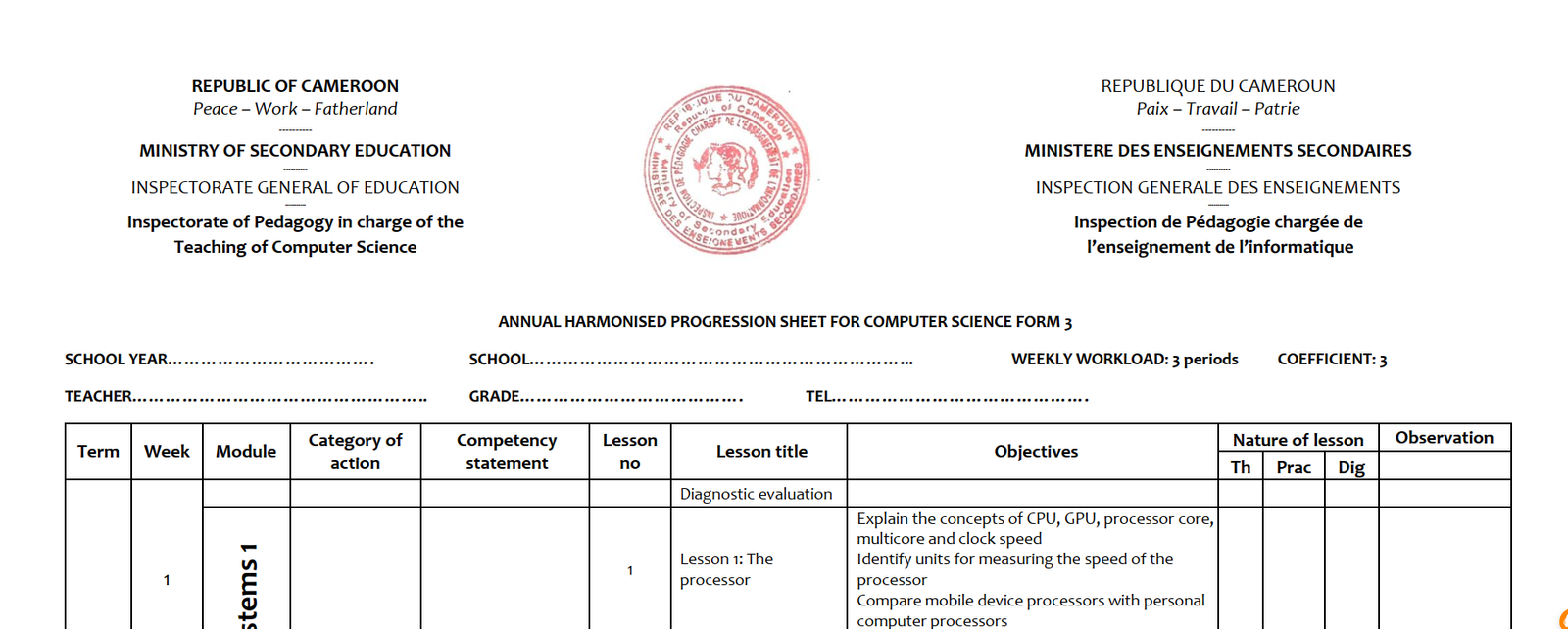cameroon gce june 2001Math meach Paper 3
TO DOWNLOAD cameroon gce june 2001 Math meach Paper 3 click on the link Below

JUNE 2001
1 Tw o particle A and B have position vectors (2 sin 2ti +2cos 2tj) m and (2ti+t2j) m respectively at time t seconds. Find
(a) the velocity of A relative to B when t = 0,
(b) the acceleration of each particle when t = π/4
(c) the value of t for which the velocities of A and B have the same magnitude,
(d) the value of t for which the acceleration of A and B are parallel and in the same sense.
2. A particle of mass 2 kg is acted on by forces F1, F2 and F3, where F1 = (4i + 6j) N,
F2 = (6i + 8k) N, F3 = (2i + 4k) N. Initially he particle is at rest at the point with position vector
(2i -3j + k) m. Find the Position vector and the magnitude of the momentum of the particle alder 4 seconds. Find also, the work done on the particle in this time.
3. A particle p is projected from a point O of a horizontal plane π with velocity u at an angle α to the plane. Taking horizontal and vertical axes Ox and Oy respectively in the plane of the particle’s path, show that the Cartesian equation of the particle’s path is
Y= xtanα – gx2 sec2α/2u2
The particle passes through the points A (180, 30) and B (240, 20).Find
(a) the time flight of P
(b) the range of P on A
(c) the greatest height of P above A
Take g as 10ms-2
4. Two elastic spheres of masses 2m kg and 7m kg collide directly. Their velocities before
impact are 6ms1 and 3ms1 respectively in the same direction and after impact they are 5/2 ms-1 and Ums-1 respectively also in the same direction. Find the value of u and the coefficient of restitution between the spheres. Find, also, the velocities of the spheres after impact if they collide directly when travelling in opposite directions, the velocity of the lighter sphere being 7ms’1 that of the heavier sphere 2ms’1- In this case determine
(a) the loss in kinetic energy due to the impact,
(b) the magnitude of the impulse experienced by the lighter sphere.
5. A car moving along a straight level road accelerates uniformly from rest until it has travelled a distance X m. It then, maintains a constant speed for 50 s and travels a further X m during this time. Finally it decelerates uniformly and comes to after travelling a further X/2 m. Find the total time for the journey.
ii) A particle P moves in a straight line. The speed v m s-1 of the particle at time t second is given by
V=kt2 – ct .When t = 0, the particle is at tire origin and when t =1, the particle is again at the origin and travelling with an acceleration of 4 m s-2. Find the values of the constants k and c. Hence find
(a) the distance covered during the first 4 seconds of moving,
(b) the acceleration of P during the third second of motion
6. Two particles of masses 3m and 5m are attached to the ends of a light inextensible string of length a which passes through a smooth fixed ring at 0. The lighter particle describes a horizontal circle about the heavier particle, which remains at rest, as centre. Show that the heavier particle is at a depth 3a/8 below 0 , and that the time for complete revolution is π√3a/2g

7.
The figure above shows a block P of a mass 40 kg on a smooth horizontal table. The block P is connected by two light in extensible strings passing over two smooth pulleys to blocks Q and R of masses 10kg and 70kg respectively. The blocks hang freely and the system is released from rest with both strings taut and the hanging part vertical. Find
(a) the magnitude of the acceleration of the system,
(b) the tension in each string.
The block R falls a distance of 2m and is brought to rest by the floor. Calculate the farther distance that Q covers before momentarily coming to rest, given that it does not reach the pulley between it and block P. [Take g as 10ms’2]
8. i) An urn contains 10 red balls and 8 yellow balls. Balls are to be drawn from the urn at random, one after the other without replacement. Calculate the probability that
(a) the first two balls drawn will both be red balls
(b) the third ball drawn will be the first red ball
(c) the first ball will be green and the second will be yellow
(d) of the first two balls drawn , one will be green and the other will be yellow
(e) the last ball drawn will be the red
(ii) The events A and B are independent. The probability of event A occurring is 1/5 and tip
probability of event B occurring is 2/5 . Find the Probability of
(f) either A or B occurring,
(g) neither A nor B occurring ,
(h) One and only of the two events occurring















